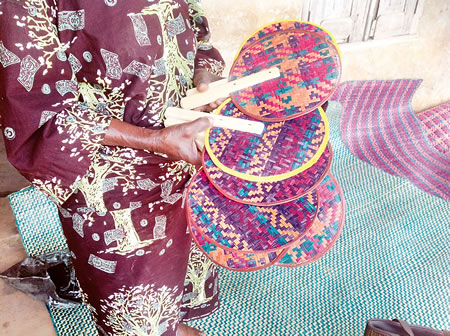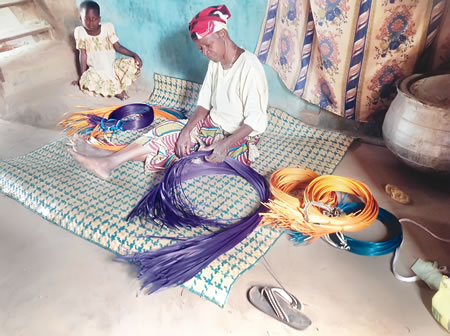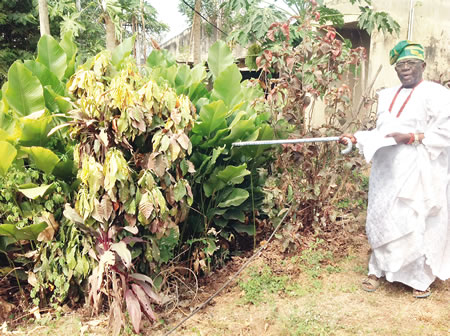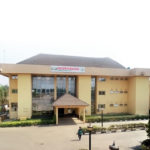SAM NWAOKO writes on the mat-weaving craft that the people of Ogotun have been known for and efforts by the Ekiti State government to give the industry a boost.
That Ogotun community in Ekiti South West Local Government Area of Ekiti State is synonymous with mat-weaving is no longer the issue. The people of the community have long accepted their craft as a way of life and are making the best of the God-given resource. The new lease on life to the legendary craft is seen in the moves by the current administration in Ekiti State to breathe fresh business air into the life of the popular craft.
The government of Dr Kayode Fayemi recently had a retreat at a location in Osun State and at the retreat, it was seen that materials made from mats from Ogotun were prominently used. These included totes, files, folders and others. A mat enthusiast and promoter, Miss Mofebisola ‘Febi Oyebade, told the Nigerian Tribune that many of the materials the government officials on retreat used for their records were “mat-based products.”
Court sentences man to death for killing brother in Lagos
‘Febi Oyebade, who runs an outfit called Estera, and also coordinates a mat-weaving centre in Ogotun community, said the government had called for some of the materials from her company, saying “they contacted us to do something for their retreat and we delivered. We were also at an exhibition for the inauguration of the government in October last year. For the retreat, they called for file folder but we call it ‘memo pad’.”

She said the demand by the state government was a sign that something good would soon happen to the craft in Ogotun-Ekiti. She said: “We are encouraged by the enthusiasm of the government of Ekiti State and this has made us at Estera to be able to encourage and enroll more people to join us in the mat craft.
“We now have new, enthusiastic people in the business. Many of those who had earlier abandoned the issue of mats due to the lack of encouragement are now coming back and bubbling with ideas.”
According to her, Estera Concepts which is run like a non-government organisation (NGO) has “a mini workshop in Ogotun where we make some products and we are expecting a new mat-weaving centre in the community soon.”
Also speaking on the new lease of life their government is bringing to the life of mat- weaving and sundry popular crafts in Ekiti State, the Director- General of the Ekiti State Council for Arts and Culture, Mr Wale Ojo Lanre, said Governor Fayemi had given them the marching orders to go all out and resuscitate the craft.
Ojo-Lanre said: “Governor Kayode Fayemi has enabled us in the Council of Arts and Culture, the Ekiti State Bureau of Labour, Productivity and Employment, other inter-related ministries to ensure the revitalisation and resuscitation of all the natural and cultural industry that are found in the state.”
In explaining the governor’s directive, Wale Ojo-Lanre said: “In Ekiti State, there are crafts that are indigenous to the state. Among them are pottery and mat-weaving. Ogotun community is the hub of mat production in Ekiti State. They are our natural industries.
“That is why the governor empowered us to meet the people in these areas and assure them of the readiness of the Fayemi-led administration to give necessary backing and assistance not only at revitalisation, but also to ensure that those coming behind are brought into the industry for the purpose of sustainability.

Thus, the new moves by the current Ekiti government would include exhibitions at local and international markets. Ojo Lanre and the Director-General of the Bureau for Labour, Productivity and Employment, Mr. Lanre Ogunjobi, recently met with the local mat weavers and the meeting was aimed at fashioning ways of improving the craft and enhance the business angle of it.
Ogotun-Ekiti
Ogotun-Ekiti is one of the three major towns that make up the South West Local Government Area of Ekiti State. To a lot of people, Ogotun is many things rolled into one. For some travellers, the community can pass for a veritable gateway. The community, to farmers, can stand its ground in agriculture and commerce as a result of the existing large farmlands. Ogotun-Ekiti also stands tall among communities with cultural ranking. Of a fact, the traditional ruler of the community, the Ologotun, is among the 16 first class traditional rulers in Ekiti State called The Pelúpelú while the reigning Ologotun, Oba Samuel Oladapo Oyebade, is the immediate past Chairman of the Ekiti State Council of Traditional rulers.
In agriculture, it is the belief among some indigenous people of Ekiti State that Ogotun has the largest farm settlements in the state. The agricultural lands of Ogotun are dotted with farmsteads that have sizable population of farmers. Members of the community claim that there are about 25 of such farmsteads, beginning with one named Olorioko community, which lies about six kilometres from the town centre.
However, Ogotun doesn’t seem to enjoy any reputation from its numerous farms as it does from a craft all have admitted it is supremely adroit at: Mat weaving. For the craft, Ogotun-Ekiti has earned a reputation that transcends age and geography. Natives of Ogotun, particularly the female folk, have sustained their ancient craft that has assumed a legendary status, both in and outside of the state, and have devised means of making a commercial success of the Ogotun mat.
For mat weaving, Ogotun has attracted the attention of government at the highest level, and the women told the Nigeria Tribune, in their acknowledgement of this fact, that the government of General Ibrahim Babangida was the most rewarding for them and their craft. The people of the community also recalled with delight what they said the government of Chief Segun Oni did with regard to the development of the people and their craft, including an exchange trip to India by one of the prominent women in the craft.

This craft stands Ogotun out
Wife of the Ogotun traditional ruler, Olori Comfort Omolade Oyebade, said the history of mat-weaving in Ogotun could be traced to the wife of Òjoruùbè, the progenitor of the town. She said the Ojorube’s wife she didn’t name had brought the craft as she migrated with her husband from Ile Ife, to found the town. According to Olori Oyebade, the wife of Òjorùbè had brought with her African serepindity berry, ‘Ewé-Iran’ in local parlance or, more commonly in Yorubaland, ‘ewé moi moi’ (a non-wooden, natural plant replete in Nigeria, thaumatococus daniellii), with which she weaved mats.
Olori Oyebade said: “The founder of this community is known as Òjorùbè. He came from Ile Ife with his wife, who came with the ‘ewe iran’. She was weaving the mats for them to sleep on and for other uses and it became incumbent on the women to take to the craft, beginning from the early days.
“In those days, there were no beds and the mat was very handy and useful. The craft grew and more women got involved. It soon became a status symbol because how rich you are determines the kind of mat you sleep on.”
The Olori added that the women devised a means to further beautify their mats by dyeing them and even got more creative as modernity crept in. She noted that as time went, “if you could afford dyed mats, you acquire them. If you cannot, you make do with the normally-woven mats. The important thing is that you slept on a mat.”
According to her, “Ijesa people are called the “eleni ate’ka, eleni ewele…” (people with mobile or portable mats). Ogotun is the community that gives life to that appellation. We are the real “Eleni ate’ka, eleni ewele”. As a matter of fact, it is said that Ogotun speaks “Ìjèsà-Ekiti”. We still speak Ìjèsà-Ekiti. Our variant of the Yoruba language is closer to Ìjèsà than it is to Ekiti. In all, this craft stands Ogotun out.”
She said what she could recall as the most glorious era for the Ogotun mat business was the reign of the military President Ibrahim Babangida. The Olori spoke glowingly of the efforts by the wife of the former president, Mrs Maryam Babangida. She recalled that the late Mrs Babangida used the opportunity of her defunct Better Life for Rural Women scheme to really make positive impact on the life of the mat-weaving women and their craft.
“Then she took many of the women to train them further in the craft and introduced more business angles to the mat trade. Then, the Better Life for Rural Women made us to realise that weaving of mats went beyond mat as something just to sleep on.
“Before the arrival of the Better Life scheme, the best our mats were used for, apart from sleeping, was to divide school or other classrooms. They also used them as ceiling for their roofs, before the asbestos became popular. But when Better Life scheme came, we realised that you could use mats for anything at all, anything you could think of.
“Bags, shoes, caps, hats, table mats, table covers, notepads, bible holders, car seat covers, window blinds, laptop bags, just anything you could conceive. When the former governor of Osun State, Mr Rauf Aregbesola, visited us, he talked about his “Òpòn Ìmò” and some of the tablets were covered with Ogotun mats.

“The options are endless. One other remarkable thing about the Better Life for Rural Women Scheme then was that no matter the amount of mat you had weaved, the scheme would buy it up. It encouraged a lot of them to expand their businesses.”
The traditional ruler’s wife also eulogised the efforts of a mat enthusiast and an exponent of Nigerian and African artifacts, Chief (Mrs) Aino Oni-Okpaku. She was honoured with the title of Yeye Afonasola of Ogotun Ekiti by Ologotun. “The Yeye Afonasola of Ogotun Ekiti is a Swede but married an Edo State man. She owns Quintessence in Lagos. Up till now, she still buys our mats. When we call her that the women have mats and that there are poor sales, she will send a bus and buy all the mats. She still does that up till today.”
Olori Oyebade said: “The Yeye Afonasola, the Swede took the Ogotun mat to 89 countries. When she attends any exhibition of crafts and she didn’t find the Ogotun mat, she’d say it’s not complete without Ogotun and refrain from taking active part. She is always there for the people: Trade fairs, exhibitions and so on. She will come around and take the women on her own and sponsor them and promote them.”
She also noted that successive governments in Ekiti State had done their bit in promoting the craft. However, she pointed out that the administration of Chief Oni did what she said was “the most in this regard.”
She said: “I will readily recall that the administration of Segun Oni did a lot for the industry. In fact, his administration did so much for the improvement of the craft and also sent one of our women to India for an exchange programme. She went there to learn their own way of making their mats and she found that they use pineapple leaves mostly. But she didn’t have western education, so her development was limited and there wasn’t so much she could do in terms of adding value to her and others’ skills. I would add that there’s no government that didn’t do one thing or the other but the most was done by the Segun Oni government in the state. Then I also remember the enormous efforts made by Mrs Feyi George, wife of a former military governor of old Ondo State.”
Women in the craft
Mrs Rechael Olarinre Ogundiran, of about 76 years of age, is popularly known by the people of the community as “Èye India.” This is because she travelled to India during the administration of Chief Segun Oni to further expand her frontiers in the craft, for which has dexterity is said to be legendary. Madam Ogundiran chuckled when asked how long she’s been weaving mats, but said that “I started as a child, having learnt from my mother, who was also doing it.”
She reiterated the notion that the craft was a common thing among the people of Ogotun and was of the opinion that it was a craft that they don’t see as something special. “Even school children do it, sometimes as home work and, maybe examination.” She held that by so doing, the craft is preserved and its development remained among the people.
Ogundiran displayed some of her products and a bag she had brought from her India journey. “The difference between India and here is that they use pineapple and plantain/banana leaves for their products. They also have equipment and are also well grounded in their craft,” she.

Èye India also recalled the “Better Life” days with some relish, and said “then we travelled round and weaved more frequently because of high volume of demand.”
Mrs Veronica Kayode’s cognomen is Èye Dudu. Her skill in the craft is also of high reputation. She was smart and businesslike in her approach to the mat-weaving discussion as she walked this reporter to her home. She showed a mat in the works, a plain mat that has been woven halfway by one of her neighbours. “When her child returns from school, she would add to the weaving and might finish it today,” she said.
Eye Dudu said the craft helped her through the difficult times that followed the death of her husband “many many years ago.” She said her skill helped her to earn money with which she paid for the education of her children in the absence of her husband. “I’ve been in the mat business since we sold mats for four kobo. I started as a child too and it really helped me then because my children were very young. Now that the mats sell for as much as between N4,000 and N4,500, the business has really come of age.
Kayode said the dyes she named as jélú (purple); mokore (green); ródosùn (red) and òrìn she said was ‘Ajoo’ in those days (beige) are bought from Ibadan.
On whether the craft is thriving, she said it was her belief that the craft is, “but only that I cannot force any child to take it up as a way of life.” According to her, “is it possible for me to tell a child that what it should do now is to weave mats the way I’m doing it for a living? What becomes of the education and all the lofty things we all aim to achieve? The children still do it but with home work from school and so on, they hardly have the time.”
For Eye Dudu, apart from the Better Life, the Oyibo woman has been another source of joy to her in her life of mat-weaving and business. When asked of her experience with the mat enthusiast, the Swedish-Nigerian and Yeye Afonosola of Ogotun-Ekiti, Chief (Mrs) Oni-Okpaku, Mrs. Kayode was all smiles.
“Ah! The woman is very good to us. Whenever she comes, we are sure she will buy. Sometimes, she buys up to 2,000 mats from the community,” she said.
What future for Eni-Iran?
For Eye India, Eye Dudu and a young mat enthusiast, Miss Mofebisola Oyebade, one of the youngsters in the business of mat-weaving and marketing, the future is in the hands of the people. For now, weaving with bare hands is the only way since there are no machines yet to do that. Weaving a mat, which could be described as building an intricate network of numerous straws, requires determination, patience and perseverance.
For those who have travelled the eni-iran road for decades and for the younger generation, there’s always the mythical Eye Eledegbe the community sings about in relation to the Ogotun mat.
Olori Oyebade explained that mythically, the people refer to the mat as Eye Eledegbe and sing its praises. “The people believe that it is a mother and that when you see Èye Elédègbe, your problem is solved in many ways. ‘Mo r’Eledegbe o, mo yó d’oke aya. O da olugba o sa ale; o da elegbewa di àsòmorò…” they’d sing of the mat,” she stated.
However, a study on mat weaving in Ogotun, carried out by some Ekiti State University (EKSU) students in May 2012, found that “the style of mat weaving of these rural dwellers no longer meets the modern global standard, as such they are faced with very low patronage and acceptability.”
WATCH TOP VIDEOS FROM NIGERIAN TRIBUNE TV
- Relationship Hangout: Public vs Private Proposals – Which Truly Wins in Love?
- “No” Is a Complete Sentence: Why You Should Stop Feeling Guilty
- Relationship Hangout: Friendship Talk 2025 – How to Be a Good Friend & Big Questions on Friendship
- Police Overpower Armed Robbers in Ibadan After Fierce Struggle






